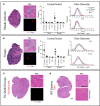AAV-mediated follistatin gene therapy improves functional outcomes in the TIC-DUX4 mouse model of FSHD
- PMID: 30429376
- PMCID: PMC6302942
- DOI: 10.1172/jci.insight.123538
AAV-mediated follistatin gene therapy improves functional outcomes in the TIC-DUX4 mouse model of FSHD
Abstract
Facioscapulohumeral muscular dystrophy (FSHD) is an autosomal dominant or digenic disorder linked to derepression of the toxic DUX4 gene in muscle. There is currently no pharmacological treatment. The emergence of DUX4 enabled development of cell and animal models that could be used for basic and translational research. Since DUX4 is toxic, animal model development has been challenging, but progress has been made, revealing that tight regulation of DUX4 expression is critical for creating viable animals that develop myopathy. Here, we report such a model - the tamoxifen-inducible FSHD mouse model called TIC-DUX4. Uninduced animals are viable, born in Mendelian ratios, and overtly indistinguishable from WT animals. Induced animals display significant DUX4-dependent myopathic phenotypes at the molecular, histological, and functional levels. To demonstrate the utility of TIC-DUX4 mice for therapeutic development, we tested a gene therapy approach aimed at improving muscle strength in DUX4-expressing muscles using adeno-associated virus serotype 1.Follistatin (AAV1.Follistatin), a natural myostatin antagonist. This strategy was not designed to modulate DUX4 but could offer a mechanism to improve muscle weakness caused by DUX4-induced damage. AAV1.Follistatin significantly increased TIC-DUX4 muscle mass and strength even in the presence of DUX4 expression, suggesting that myostatin inhibition may be a promising approach to treat FSHD-associated weakness. We conclude that TIC-DUX4 mice are a relevant model to study DUX4 toxicity and, importantly, are useful in therapeutic development studies for FSHD.
Keywords: Gene therapy; Mouse models; Muscle Biology; Neuromuscular disease; Therapeutics.
Conflict of interest statement
Figures






Similar articles
-
Transgenic mice expressing tunable levels of DUX4 develop characteristic facioscapulohumeral muscular dystrophy-like pathophysiology ranging in severity.Skelet Muscle. 2020 Apr 11;10(1):8. doi: 10.1186/s13395-020-00227-4. Skelet Muscle. 2020. PMID: 32278354 Free PMC article.
-
RNA interference inhibits DUX4-induced muscle toxicity in vivo: implications for a targeted FSHD therapy.Mol Ther. 2012 Jul;20(7):1417-23. doi: 10.1038/mt.2012.68. Epub 2012 Apr 17. Mol Ther. 2012. PMID: 22508491 Free PMC article.
-
DUX4 Transcript Knockdown with Antisense 2'-O-Methoxyethyl Gapmers for the Treatment of Facioscapulohumeral Muscular Dystrophy.Mol Ther. 2021 Feb 3;29(2):848-858. doi: 10.1016/j.ymthe.2020.10.010. Epub 2020 Oct 15. Mol Ther. 2021. PMID: 33068777 Free PMC article.
-
A complex interplay of genetic and epigenetic events leads to abnormal expression of the DUX4 gene in facioscapulohumeral muscular dystrophy.Neuromuscul Disord. 2016 Dec;26(12):844-852. doi: 10.1016/j.nmd.2016.09.015. Epub 2016 Sep 19. Neuromuscul Disord. 2016. PMID: 27816329 Review.
-
Facioscapulohumeral dystrophy: activating an early embryonic transcriptional program in human skeletal muscle.Hum Mol Genet. 2018 Aug 1;27(R2):R153-R162. doi: 10.1093/hmg/ddy162. Hum Mol Genet. 2018. PMID: 29718206 Free PMC article. Review.
Cited by
-
A novel P300 inhibitor reverses DUX4-mediated global histone H3 hyperacetylation, target gene expression, and cell death.Sci Adv. 2019 Sep 11;5(9):eaaw7781. doi: 10.1126/sciadv.aaw7781. eCollection 2019 Sep. Sci Adv. 2019. PMID: 31535023 Free PMC article.
-
Have a Little Heart (or Not): Highly Minimized Skeletal Muscle Regulatory Cassettes with Low or No Activity in the Heart.Hum Gene Ther. 2024 Aug;35(15-16):543-554. doi: 10.1089/hum.2024.041. Epub 2024 Jul 19. Hum Gene Ther. 2024. PMID: 38970421 Free PMC article.
-
Long-Term Systemic Treatment of a Mouse Model Displaying Chronic FSHD-like Pathology with Antisense Therapeutics That Inhibit DUX4 Expression.Biomedicines. 2022 Jul 7;10(7):1623. doi: 10.3390/biomedicines10071623. Biomedicines. 2022. PMID: 35884928 Free PMC article.
-
Mouse models for muscular dystrophies: an overview.Dis Model Mech. 2020 Feb 21;13(2):dmm043562. doi: 10.1242/dmm.043562. Dis Model Mech. 2020. PMID: 32224495 Free PMC article. Review.
-
Single-cell and spatial transcriptomics identify a macrophage population associated with skeletal muscle fibrosis.bioRxiv [Preprint]. 2023 Apr 18:2023.04.18.537253. doi: 10.1101/2023.04.18.537253. bioRxiv. 2023. Update in: Sci Adv. 2023 Jul 7;9(27):eadd9984. doi: 10.1126/sciadv.add9984. PMID: 37131694 Free PMC article. Updated. Preprint.
References
-
- Flanigan K. Facioscapulohumeral muscular dystrophy and scapuloperoneal disorders. In: Engel A, Franzini-Armstrong C, eds. Myology. New York, NY: McGraw-Hill Medical Publishing Division; 2004:1123-1133.
-
- Padberg G. Facioscapulohumeral Disease. Netherlands; Leiden University: 1982.
Publication types
MeSH terms
Substances
Grants and funding
LinkOut - more resources
Full Text Sources
Other Literature Sources
Medical
Molecular Biology Databases
Research Materials

